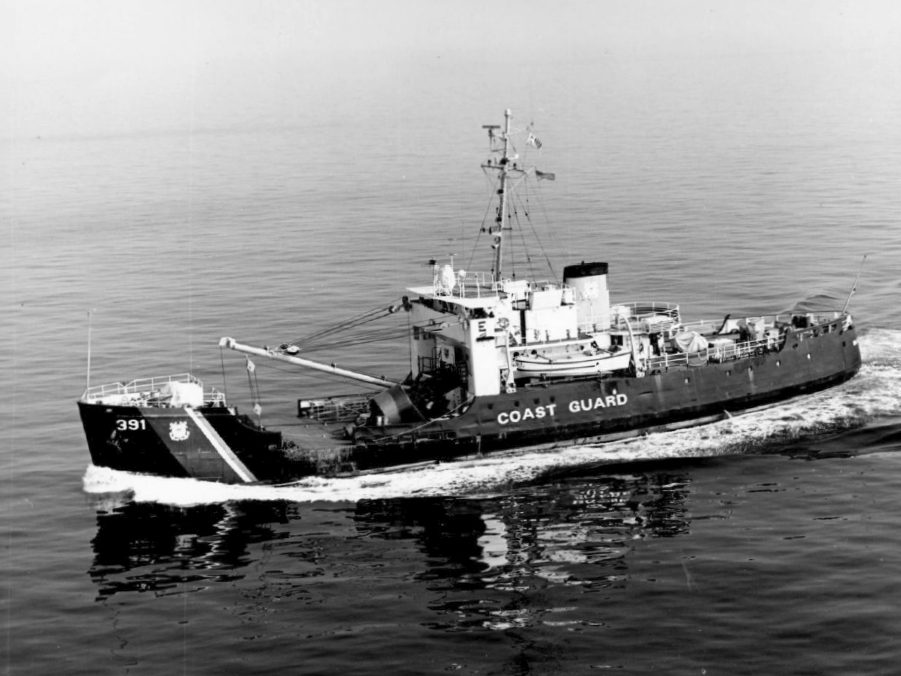U.S. Coast Guard Photo
By Michael Carr – He braced himself against the ship’s starboard side and stared inward through the chartroom’s one porthole. He inhaled and exhaled, listening to his exhaust bubbles heading toward the surface 50 feet away. This was the only sound, his rhythmic inhaling and exhaling.
He was transfixed. Inside the chartroom was the body of a drowned Coastie, floating eerily in the cramped space. Chartrooms on 180-foot Coast Guard buoy tenders are small, maybe 12 feet by 6 feet. Most of this space is taken up with filing cabinets, a chart table, radar amplifiers, and safes. There is one porthole, on the starboard side, directly across from the door. With a diameter of one foot, the porthole is too small for a person to climb through.
As the diver’s eyes adjusted to the dimly lit chartrooms interior, he could see a filing cabinet lying against the chartrooms door. Slowly it became clear to the diver what must have happened.
When the Cutter sank, she had landed on her portside with the chart room door on the downward side. This filing cabinet must have broken loose and landed against the door, which opens inward from the narrow passageway which leads to the bridge, blocking the only exit from the chartroom.
The diver began to visualize what had happened, first the collision with the inbound freighter, the buoy tender pushed to starboard, and then pulled to port and dragged backwards with a huge hole in her side caused by the freighter’s anchor.
Within minutes the Cutter had filled with water and sank. Twenty-three of the fifty-person crew drowned. Most of the twenty-three had not yet been found. He had found one of the crew, trapped in the ladder well on the stern which leads to “officers country”.
Now he had found this second Coastie, trapped in the Chartroom. He had been able to free the Coastie from the stern ladder well, and been taken him to the surface, but the Coastie in the chartroom was going to be a challenge.
“Topside, this is Red Diver,” he said through his helmet’s microphone. He was diving the Navy’s new Mark 12 Hard Hat diving system, which was quiet compared to previous diving helmets.
“Red Diver this is Topside, go ahead,” came back through his headphones.
“I am on the starboard side, at the pilothouse, looking inside through the chartroom porthole. I have a “package” inside. “Package” was code word for a body. There were too many people topside on the salvage barge. Everyone there could hear the conversations with the divers.
Hearing the word “body” would detract from what was needed now, an unemotional and focused approach to locating the drowned crew, and preparing the vessel for salvage. Stay focused, stay on task, accomplish the mission.
“Red diver, this is topside, can you gain access to the package?”
“I am not sure, possibly from the interior if I can push open the chartroom door.”
“Roger that, can you gain access to the interior?”
“Yes, I can enter through the starboard bridge wing door, drop down to the port side, and go down the passageway to the chartroom door.”
“Red Diver, topside, go ahead and make your entrance, keep us updated on your progress.”
“Topside, Red Diver, roger that, entering the bridge now”. He knew the interior of the 180-foot class buoy tender intimately. He had served on a sister ship in Alaska for two years, and could navigate inside every space with his eyes closed.
He quickly made his way to the passageway, which led to the chartroom door. With the cutter on her portside the chartroom door was over him. He crouched on the port bulkhead. His eyes were momentarily drawn to fancy rope work on the handrails, done by dedicated Bos’n mates over decades of time.
His exhaust bubbles piled up against the chartroom door, and what had been the passageway’s starboard bulkhead. Everything seemed so wrong and dislocated. He braced his legs and pushed against the door. No movement. He pushed again, and again. He changed his position and pushed. His breathing increased, and he adjusted his air control valve to allow more air into his helmet.
“Topside, Red Diver.”
“Go ahead Red.”
“I can’t budge the door, there is no movement, the weight of the filing cabinet is too much.”
“Red Diver, understand, move out and keep searching towards the bow.”
He retraced his path, following his umbilical back out of the bridge and continued moving forward, peering in the mess-deck portholes and crane control booth. No more “packages” were found on his dive.
Weeks later, when the cutter was righted and raised to the surface, he would enter the chartroom again, this time wearing an SCBA and HAZMAT coveralls, and recover this Coastie. Later analysis would reveal the filing cabinet holding the chartroom door closed had not been bolted down, but just sitting unrestrained in the chartroom. Nothing had held it in place.
In the years following, when he sailed as a Chief Mate and then Master on vessel he would tell his crews this story when he instructed them to “Secure for Sea”.
“Don’t get killed by a filing cabinet,” he would say, and he was serious.

 Join The Club
Join The Club











